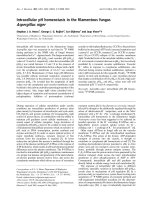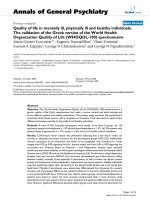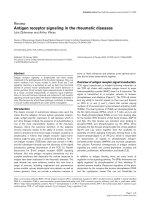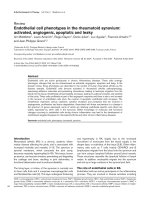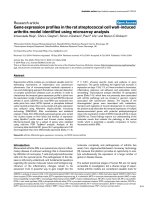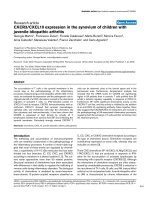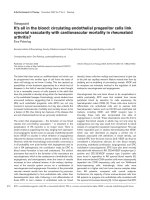Báo cáo y học: "Coronary arteriovenous fistulas in the adults: natural history and management strategies" pptx
Bạn đang xem bản rút gọn của tài liệu. Xem và tải ngay bản đầy đủ của tài liệu tại đây (350.99 KB, 5 trang )
BioMed Central
Page 1 of 5
(page number not for citation purposes)
Journal of Cardiothoracic Surgery
Open Access
Research article
Coronary arteriovenous fistulas in the adults: natural history and
management strategies
Yusuf Ata*
1
, Tamer Turk
1
, Murat Bicer
2
, Mihriban Yalcin
1
, Filiz Ata
3
and
Senol Yavuz
1
Address:
1
Bursa Yuksek Ihtisas Education and Research Hospital, Department of Cardiovascular Surgery, Bursa, Turkey,
2
Uludag University
Medical Faculty, Department of Cardiovascular Surgery, Bursa, Turkey and
3
Bursa Yuksek Ihtisas Education and Research Hospital, Department of
Anesthesiology, Bursa, Turkey
Email: Yusuf Ata* - ; Tamer Turk - ; Murat Bicer - ;
Mihriban Yalcin - ; Filiz Ata - ; Senol Yavuz -
* Corresponding author
Abstract
Objective: To describe aspects of the natural history and pathophysiology of coronary
arteriovenous fistula and to propose potential treatment strategies.
Methods: Eleven adult patients were treated surgically for coronary arteriovenous fistulas (8 male,
3 female) during the last three years. Mean age was 48,7 ± 9,5 years (range 32-65 years). Diagnosis
was made by coronary angiography and transesophageal echocardiography
Results: All patients were symptomatic due to the associating cardiac disorder or fistula.
Presenting symptoms were chest pain, exertional dyspnea and palpitation. All patients were
diagnosed by selective angiography. Transthoracic and transoesophageal echocardiography was
performed to identify the Qp/Qs ratio in one patient. One patient who had an LAD to pulmonary
artery coronary arteriovenous fistula with a vascular malformation needed early reoperation due
to recurrence of the fistula. Echocardiographic evaluation at the postoperative third month
revealed no residual shunts in all patients.
Conclusion: Because of the severe complications that may develop due to coronary
arteriovenous fistula, we believe that every coronary artery fistula should be treated invasively by
surgery or transcatheter closure. But both treatment modalities still need to be evaluated with
randomized multicenter studies for long term survival and effectiveness.
Introduction
Coronary arteriovenous fistula (CAVF) is rare anomaly
which consists of abnormal communication between cor-
onary artery and one of the cardiac chambers or vessels
adjacent to the heart. Coronary arteriovenous fistulas
(CAVFs) are present in 0.002% of the general population
and are visualized in nearly 0.25% of patients undergoing
catheterization [1-5].
Most of the patients with CAVFs are older than 20 years.
Although they remain asymptomatic, symptoms and
complications may develop with increasing age, and
Published: 6 November 2009
Journal of Cardiothoracic Surgery 2009, 4:62 doi:10.1186/1749-8090-4-62
Received: 9 September 2009
Accepted: 6 November 2009
This article is available from: />© 2009 Ata et al; licensee BioMed Central Ltd.
This is an Open Access article distributed under the terms of the Creative Commons Attribution License ( />),
which permits unrestricted use, distribution, and reproduction in any medium, provided the original work is properly cited.
Journal of Cardiothoracic Surgery 2009, 4:62 />Page 2 of 5
(page number not for citation purposes)
when surgery is performed in later life mortality and mor-
bidity is increased [6,7]. We present our experience in
eleven adult patients with CAVFs, document diagnostic
evaluation and management strategies. The objective of
this study was to describe aspects of the natural history
and pathophysiology of CAVF and to propose potential
treatment strategies.
Methods
Patients
In the last three years 11 adult patients with CAVFs were
treated surgically in two hospitals. The mean age was 48,7
± 9,5 years (range 32-65 years). Coronary angiography
was performed in all patients due to presenting symptoms
and associated cardiac disorder. Transthoracic and tran-
soesophageal echocardiography was performed to iden-
tify the Qp/Qs ratio in one patient.
All patients were symptomatic, presenting symptoms
were angina, exertional dyspnea and palpitation. Clinical
symptoms mostly depended on the associated cardiac dis-
order.
Results
Coronary angiography revealed 12 CAVFs originating
from the proximal left descending artery (n = 8) (Fig 1),
the left main coronary (n = 1), and the right coronary
artery (n = 3). One patient (9,1%) had bilateral fistulas
with origin from the right coronary artery and the left
descending artery. The majority of the CAVFs (n = 11)
drained into the main pulmonary artery. Only in one case
(6.6%) fistula drained from right coronary artery into cor-
onary sinus with an aneurysm of the right coronary artery
(Fig 2). RCA to Coronary Sinus fistula patient was evalu-
ated with transthoracic and transosephageal echocardiog-
raphy which showed normal contractile function with a
Qp/Qs ratio 2.4/1.
Surgical correction was performed in all patients via
median sternotomy. Seven patients were operated with
the use of the cardiopulmonary bypass (CPB). Heparin
was administrated (300 U/kg) before aortic cannulation.
Anticoagulation was maintained during CPB and moni-
tored with activated clotting time measurements (Hemo-
chron 801, International Technique Corp, Edison, NJ,
USA). We performed moderate systemic hypothermia
(30°C-32°C) in all the patients. A roller pump, a non-
heparinized circuit and a hollow-fiber oxygenator were
used. The pump flow was kept between 2.0-2.5 L/min/m2
body surface area to maintain a mean arterial pressure of
50 to 70 mmHg. Ascending aorta was clamped after the
clamping of the CAVF near to the drainage area. Myocar-
dial protection was achieved by an initial antegrade infu-
sion of the St. Thomas' crystalloid cardioplegia and then
continued with intermittent antegrade cold blood cardio-
plegia.
Other four patients were operated on beating heart with-
out the use of CPB. After a median sternotomy heparin
(150 U/kg) was administered. The Octopus Tissue Stabi-
lizer (Octopus-4, Medtronic, Cardiac Surgical Products,
MI, USA) was used for the stabilization of the target coro-
nary artery. Heparin was antagonized with protamin sul-
phate until the activated clotting time decreased below
200 seconds.
All CAVFs are visible at the surface of the heart and a con-
tinuous thrill was palpable over all of the CAVFs. All
CAVFs were dissected near their origins and were tempo-
rarily occluded with bulldog clamps until the thrill disap-
Dilated right coronary artery and coronary arteriovenous fis-tula draining into the coronary sinusFigure 2
Dilated right coronary artery and coronary arteriov-
enous fistula draining into the coronary sinus.
Coronary arteriovenous fistula between LAD and pulmonary arteryFigure 1
Coronary arteriovenous fistula between LAD and
pulmonary artery.
Journal of Cardiothoracic Surgery 2009, 4:62 />Page 3 of 5
(page number not for citation purposes)
peared for 20 minutes. After this period CAVFs were
ligated both proximally and distally at the origin and the
drainage site. The operations performed in association
with closure of the CAVFs are listed in Table 1.
There was no surgical death; only one patient with recur-
rence of the fistula that was operated on beating heart
needed early reoperation. This patient had a vascular mal-
formation located on the main pulmonary trunk, after
clamping and surgical ligation of the fistula the thrill dis-
appeared but in the ICU the thrill appeared again. Coro-
nary angiography revealed a fistula between LAD and the
pulmonary artery. The patient was reoperated with CPB
and the pulmonary connection of the fistula was ligated
after opening the pulmonary trunk. All patients under-
went echocardiography at the postoperative third month
which revealed no residual shunts in all patients.
Discussion
CAVF is a very rare anomaly. It was firstly described by
Krause in 1865 and the first surgical treatment was also
done by Bjork and Crafoord in 1947 [8,9]. CAVFs consti-
tute nearly half of all coronary artery anomalies and are
the most common of hemodynamically significant coro-
nary lesions [1-7]. Approximately half of all patients with
CAVF remain asymptomatic and some CAVF might disap-
pear spontaneously during childhood [4,5,7,10,11].
CAVF may be congenital or acquired. CAVFs are associ-
ated with an other congenital heart disease in 20% to 45%
and isolated in 55% to 80% of the cases [3,4,6,12]. Asso-
ciated anomalies include atrial septal defect, tetralogy of
Fallot, patent ductus arteriosus, ventricular septal defect,
and pulmonary atresia [1,3,4,6].
Origin of the CAVF can be any of the three major coronary
arteries, including the left main trunk. The majority of
these fistulas arise from the right coronary arteries or the
left anterior descending; the circumflex coronary artery is
rarely involved [1,4-6]. Single origin is the most common
form of CAVF, ranging from 74% to 90% of the cases
[1,4,6,12]. The right coronary artery or its branches is the
most common site of the CAVFs with 55% and the second
common site is the left coronary artery in about 35% of
the cases [5]. In contrast with the majority of the literature
but similar to the observations of Tirolimis et al. and Car-
rel et al. most of the CAVFs (75%) in our study group were
originating from the left coronary artery and only 3 (25%)
CAVFs were originating from the right coronary artery
[13,14]. This might be because our small population
study group is only consisted of adult patients. Multiple
fistulas may be present in 10.7% to 16%, and fistulas
might originate from both coronaries in 4% to 18% of the
cases [1-6]. One (9%) of our cases also has double CAVFs
originating both from right coronary artery and left coro-
nary artery (Table 1).
Over 90% of the fistulas drain into the venous structures
of circulation. These include right-sided chambers, pul-
monary artery, coronary sinus, and superior vena cava but
drainage into the left-sided chambers is less frequent. Fis-
tulous drainage occurs into the right ventricle in 40%,
right atrium in 26%, pulmonary artery in 17%, left ventri-
cle in 3%, coronary sinus in 7%, and superior vena cava in
1% [4-6]. Drainage site was into the pulmonary artery in
10 patients and into the coronary sinus in one (Table 1).
This difference should be due to our older aged study
group which was shown by Urrutia et al. that drainage
into the main pulmonary artery are a relatively common
occurrence, especially in patients with increasing age [3].
Coronary artery dilatation is common but degree of dila-
tation does not always depend on the shunt size. In one
of our case that was draining into the coronary sinus there
was a notable dilatation in the right coronary artery (Fig
2).
The majority of the adult patients remain asymptomatic
according to size and localization of the CAVF. Sympto-
matic adult patients may have symptoms of dyspnea,
fatigue, and angina these symptoms might be due to con-
comitant presence of underlying cardiac disease [3,7,13].
CAVF may result in severe complications; such as pulmo-
nary hypertension because of an existing large left to right
shunt, congestive heart failure, subacute bacterial endo-
carditis, myocardial ischemia resulting from steal phe-
nomena, rupture or thrombosis of the CAVF or
associating arterial aneurysm [5,6]. Symptoms and risk of
these lethal complications increase with age [6,7,13].
Table 1: Origin, drainage site of the CAVFs and the surgical
treatment performed
Patient Age Origin Drainage Treatment
1 46 LAD PA SC+OPCABG
2 50 LAD PA SC+OPCABG
3 53 LAD PA SC+OPCABG
4 51 RCA PA SC+MVR+CABG
5 46 LMCA PA SC+CABG
6 56 LAD PA SC+CABG
7 58 LAD PA SC+CABG
8 37 LAD PA SC+OPCABG
9 42 LAD and RCA PA-PA SC+CABG
10 32 RCA CS SC
11 65 LAD PA SC+CABG
LAD, left anterior descending coronary artery; PA, pulmonary artery;
SC, surgical closure; OPCABG, off-pump coronary artery bypass
grafting; RCA, right coronary artery; MVR, mitral valve replacement;
LMCA, left main coronary artery; CABG, on-pump coronary artery
bypass grafting
Journal of Cardiothoracic Surgery 2009, 4:62 />Page 4 of 5
(page number not for citation purposes)
The diagnosis of CAVF challenging as its prevalence is low,
yet it should be considered in many symptomatic or
asymptomatic patients presenting with cardiac murmurs.
Differential diagnosis includes patent ductus arteriosus,
pulmonary arteriovenous fistula, ruptured sinus of Val-
salva aneurysm, aortopulmonary window, prolapse of the
right aortic cusp with a supracristal ventricular septal
defect, internal mammary artery to pulmonary artery fis-
tula, and systemic arteriovenous fistula [5,6,15].
Traditional way of diagnosis of CAVF is invasive investiga-
tions such as cardiac catheterization and coronary angiog-
raphy. Most of the fistulas are small and found
incidentally during coronary angiography. Coronary ang-
iography still remains the gold standard for imaging the
coronary arteries, but sometimes origin and relation of
CAVF to adjacent cardiac structures may be ambiguous. It
is difficult to measure and observe abnormal tortuous
blood vessels with coronary angiography in one section,
under such conditions non-invasive methods such as
transthoracic echocardiography combined with Doppler
and color flow imaging, transoesophageal echocardiogra-
phy, magnetic resonance imaging and contrast enhanced
multislice tomography can be used as adjunct to coronary
angiography [5,6,16-18].
Although the natural history of the CAVF is variable and
some spontaneous closure is reported it is widely recom-
mended by most of the authors that symptomatic CAVF
should be treated, but is still controversial in patients
without symptoms [3,7,10,11,19-21]. Some authors rec-
ommend closure of CAVF even in asymptomatic patients
to prevent fistula related complications those will increase
with age, especially because of the risk of heart failure,
endocarditis and myocardial ischemia [3,6,13,22]. The
authors of the present study accepted this recommenda-
tion and proposed closure of the diagnosed CAVFs. Most
of the patients presented in our study had concomitant
cardiac diseases therefore these diagnosed CAVFs were
important in the planning and the performance of the sur-
gical treatment of the coexisting cardiac disease. On the
other hand in these cases the closure of the CAVFs should
be performed to reduce postoperative early and late com-
plications.
Surgical closure of CAVF by epicardial and endocardial
ligations are gold standard for the treatment of CAVF and
remains safe and effective with good reported success
[13,22-24]. Some authors have reported successful surgi-
cal occlusion of CAVF on beating heart without cardiopul-
monary bypass [2,25]. Ligation of the CAVF may be
performed on the outside of the heart without CPB bypass
when there is a simple and easily accessible CAVF. But we
recommend exploration of the pulmonary artery with the
use of cardiopulmonary bypass especially in patients hav-
ing a CAVF in combination with a vascular malformation
as in our patient that needed reoperation because after the
surgical occlusion of the dominant left to right shunt in
the CAVF omitted communication in the vascular malfor-
mation can cause late recurrence.
There is an increase in TCC treatment of CAVF in recent
years with the use of advanced interventional devices
[21,26]. TCC closure technique needs several conditions:
anatomy of the fistula should be favorable for this treat-
ment (eg. nontortuose vessel, the fistula should be unique
with distal narrowing to avoid embolism to the drainage
site, and distal portion of the fýstula should be accessible
with the closure device [20,21,26].
Conclusion
In the light of the literature we recommend the following
as a treatment strategy: (1) patient with a symptomatic or
an asymptomatic CAVF and an additional cardiac pathol-
ogy that needs surgical intervention should refer to surgi-
cal closure; (2) patient with a symptomatic or
asymptomatic CAVF and unsuitable anatomy for TCC clo-
sure should refer to surgical closure; (3) patient with a
symptomatic or an asymptomatic CAVF and a suitable
anatomy TCC should refer to TCC; (4) patient with a
symptomatic or an asymptomatic CAVF with a coexisting
cardiac pathology that needs percutaneous coronary inter-
vention should refer to TCC; and (5) patient with a failed
TCC should refer to surgical closure.
In conclusion, surgical closure of the CAVF can be per-
formed with very low risk especially on the beating heart
and in cases of isolated CAVF with suitable anatomy TCC
is the alternative treatment selection. But yet surgery and
especially TCC closure needs to be evaluated with rand-
omized multicenter studies for long-term survival and
effectiveness of the both therapeutic modalities.
Competing interests
Next Pharma financed the article processing charge of this
article.
Authors' contributions
YA participated in collecting the data, writing, reviewing
and submitting the manuscript. TT conceived of the study,
participated in writing and submitting the manuscript.
MB participated in collecting the data and reviewing the
manuscript. MY participated in collecting the data and
reviewing the manuscript. FA participated in reviewing
and in writing of the manuscript. SY participated in
reviewing of the manuscript. All authors read and
approved the final manuscript.
References
1. Fernandes ED, Kadivar H, Hallman GL, Reul GJ, Ott DA, Cooley DA:
Congenital malformations of the coronary arteries: the
Publish with BioMed Central and every
scientist can read your work free of charge
"BioMed Central will be the most significant development for
disseminating the results of biomedical research in our lifetime."
Sir Paul Nurse, Cancer Research UK
Your research papers will be:
available free of charge to the entire biomedical community
peer reviewed and published immediately upon acceptance
cited in PubMed and archived on PubMed Central
yours — you keep the copyright
Submit your manuscript here:
/>BioMedcentral
Journal of Cardiothoracic Surgery 2009, 4:62 />Page 5 of 5
(page number not for citation purposes)
Texas Heart Institute experience. Ann Thorac Surg 1992,
54:732-740.
2. Olearchyk AS, Runk DM, Alavi M, Grosso MA: Congenital bilateral
coronary-to-pulmonary artery fistulas. Ann Thorac Surg 1997,
64:233-235.
3. Urrutia-S CO, Falaschi G, Ott DA, Cooley DA: Surgical manage-
ment of 56 patients with congenital coronary artery fistulas.
Ann Thorac Surg 1983, 35:300-307.
4. Dodge-Khatami A, Mavroudis C, Backer CL: Congenital Heart
Surgery Nomenclature and Database Project: anomalies of
the coronary arteries. Ann Thorac Surg 2000, 69:270-297.
5. Gowda RM, Vasavada BC, Khan IA: Coronary artery fistulas: clin-
ical and therapeutic considerations. Int J Cardiol 2006, 107:7-10.
6. Levin DC, Fellows KE, Abrams HL: Hemodynamically significant
primary anomalies of the coronary arteries. Angiographic
aspects. Circulation 1978, 58:25-34.
7. Liberthson RR, Sagar K, Berkoben JP, Weintraub RM, Levine FH:
Congenital coronary arteriovenous fistula: report of 13
patients, review of the literature and delineation of manage-
ment. Circulation 1979, 59:849-853.
8. Krause W: Ueber den Ursprung einer akzessorischen A. cor-
onaria aus der A. pulmonalis. Z Ratl Med 1865, 24:225-9.
9. Bjork G, Crafoord C: Arteriovenous aneurysm on the pulmo-
nary artery simulating patent ductus arteriosus botalli. Tho-
rax 1947, 2:65.
10. Farooki ZQ, Nowlen T, Hakimi M, Pinsky WW: Congenital coro-
nary artery fistulae: a review of 18 cases with special empha-
sis on spontaneous closure. Pediatr Cardiol 1993, 14:208-213.
11. Griffiths SP, Ellis K, Hordof AJ, Martin E, Levine OR, Gersony WM:
Spontaneous complete closure of a congenital coronary
artery fistula. J Am Coll Cardiol 1983, 2:1169-1173.
12. Vitarelli A, De Curtis G, Conde Y, Colantonio M, Di Benedetto G,
Pecce P, De Nardo L, Squillaci E: Assessment of congenital coro-
nary artery fistulas by transesophageal color Doppler
echocardiography. Am J Med 2002, 113:127-33.
13. Tirilomis T, Aleksic I, Busch T, Zenker D, Ruschewski W, Dalichau H:
Congenital coronary artery fistulas in adults: surgical treat-
ment and outcome. Int J Cardiol 2005, 98:57-9.
14. Carrel T, Tkebuchava T, Jenni R, Arbenz U, Turina M: Congenital
coronary fistulas in children and adults: diagnosis, surgical
technique and results. Cardiology 1996, 87:325-30.
15. Guray U, Guray Y, Ozbakir C, Yilmaz MB, Sasmaz H, Korkmaz S: Fis-
tulous connection between internal mammary graft and pul-
monary vasculature after coronary artery bypass grafting: a
rare cause of continuous murmur. Int J Cardiol 2004, 96:489-92.
16. Aydogan U, Onursal E, Cantez T, Barlas C, Tanman B, Gurgan L:
Giant congenital coronary artery fistula to left superior
venacava and right atrium with compression of left pulmo-
nary vein simulating cor triatratum: diagnostic value of mag-
netic resonance imaging. Eur J Cardiovasc Surg 1994, 8:97-9.
17. Ropers D, Moshage W, Daniel WG, Jessl J, Gottwik M, Achenbach S:
Visualization of coronary artery anomalies and their ana-
tomic course by contrast-enhanced electron beam tomogra-
phy and three-dimensional reconstruction. Am J Cardiol 2001,
15:193-197.
18. Chee TS, Tan PJ, Koh SK, Jayaram L: Coronary artery fistula diag-
nosed by transthoracic Doppler echocardiography. Singapore
Med J 2007, 48:262-264.
19. Bogers AJJC, Quaegebeur JM, Huysans HA: Early and late results
of surgical congenital coronary artery fistula. Thorax 1987,
42:369-373.
20. Mavroudis C, Backer CL, Rocchini AP, Muster AJ, Gevitz M: Coro-
nary artery fistulas in infants and children: a surgical review
and discussion of coil embolization. Ann Thorac Surg 1997,
63:1235-1242.
21. Armsby LR, Keane JF, Sherwood MC, Forbess JM, Perry SB, Lock JE:
Management of coronary artery fistulae. Patient selection
and results of transcatheter closure. J Am Coll Cardiol 2002,
39:1026-1032.
22. Balanescu S, Sangiorgi G, Castelvecchio S, Medda M, Inglese L: Coro-
nary artery fistulas: clinical consequences and methods of
closure: a literature review. Ital Heart J
2001, 2:669-76.
23. Kamiya H, Yasuda T, Nagamine H, Sakakibara N, Nishida S, Kawasuji
M, Watanabe G: Surgical treatment of congenital coronary
artery fistulas: 27 years' experience and a review of the liter-
ature. J Card Surg 2002, 17:173-177.
24. Benlafqih C, Leobon B, Chabbert V, Glock Y: Surgical exclusion of
a symptomatic circumflex coronary to right atrium fistula.
Interact CardioVasc Thorac Surg 2007, 6:413-415.
25. Hoendermis ES, Waterbolk TW, Willems TP, Zijlstra F: Large com-
mon left and right coronary artery to coronary sinus fistula.
Interact Cardiovasc Thorac Surg 2006, 6:788-9.
26. Perry SB, Rome J, Keane JF, Baim DS, Lock IE: Transcatheter clo-
sure of coronary artery fistulas. J Am Coll Cardiol 1992,
20:201-209.


